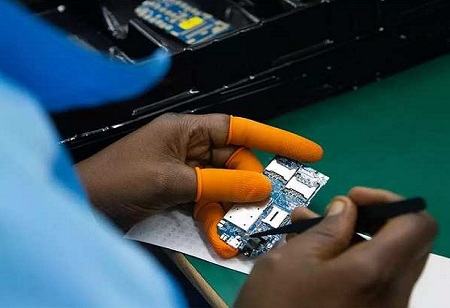India should set up distribution centres for the semiconductor sector to facilitate a global supply chain in order to attract firms worldwide, ending Hong Kong and Singapore leadership, an industry group said.
"In order to participate in global supply chains of semiconductors, India needs a policy for global companies to set up global distribution centers out of India," Vivek Tyagi, chairman, India Electronics & Semiconductor Association (IESA) said.
The Bengaluru-based group represents multinationals such as Taiwanese MediaTek, Dutch NXP Semiconductors and the US-based Qualcomm.
The distribution centres, according to Tyagi, should be set up on the lines of special economic zones (SEZ) so that it would become easier for multinationals to enable semiconductor shipments, with most of them based in Singapore and Hong Kong.
Last year, the Centre modified the semiconductor policy unveiled in 2021, allowing a 50% incentives for semiconductor fabs across technology nodes to boost investments in the sector.
Earlier, only the 28nm or lower chipset makers were eligible for up to 50% incentive of the project cost. With a revised policy, those producing above 28nm have also become eligible for a similar incentive.
"Government's semiconductor policy is one of the well-designed initiatives in the world," the executive said, adding that the policy would take some time to fructify since global players lay out their plans for fabs at least five years in advance.
Following the semiconductor shortage and supply chain disruptions on the back of Covid-19
pandemic, countries including India have realised necessity to shun overseas dependency on semiconductors. In December 2021, the Cabinet headed by Prime Minister Narendra Modi cleared the ambitious semiconductor initiative with a fiscal outlay of INR 76,000 crore which is fungible across different schemes.
In a joint venture (JV) with Taiwan’s Hon Hai Technology Group, also known as Foxconn, Vedanta Semiconductors, a part of Anil Agarwal-owned domestic commodities conglomerate, is expected to set up a semiconductor plant in Gujarat at an estimated investment of Rs 1.55 lakh crore in 2025.
Skillset availability, however, is considered as one of the critical areas that has so far discouraged global giants to set up their manufacturing units in India.
"The government has plans for skilling. India already has 20% of global semiconductor design engineers. In the next few years, the country will need about 100,000 skilled workforce. We need to fine tune existing academic programs to be targeted at semiconductor manufacturing to create skilled manpower," Tyagi said.
"2022 began with many semiconductor devices in shortage resulting in extended lead times and increasing pricing which led to reduced electronic equipment production for many end markets. As a result, OEMs started hedging themselves from shortages by stockpiling chip inventory," said Andrew Norwood, VP Analyst at Gartner.
Last week, IT and Communications minister Ashwini Vaishnaw said that India is aiming to be a semiconductor supplier for the world, and the government is putting in $10 billion with a long-haul program in the semiconductor sector.
"Our university system that produces a large number of talent is also helping a lot as we have tied up with many universities to prepare the right talent," the minister added.
Country's semiconductor component market is expected to see cumulative revenues rise to $300 billion during the 2021-2026 period, according to a recent Counterpoint finding.
"Semiconductor is a very critical industry of any country. It is at the centre stage of geopolitics today. Venture capitalists may want some more concessions from the government," AJ Paulraj, venture partner at Celesta Capital, and Emeritus Professor at Stanford University earlier said.
In 2021, mobile and wearables alone contributed 51% of the semiconductor revenues in India.
India Semiconductor Mission (ISM) that had been setup as an independent business division would enable collaborative programs with national and international agencies, industries and institutions for catalysing research, commercialisation and skill development.
